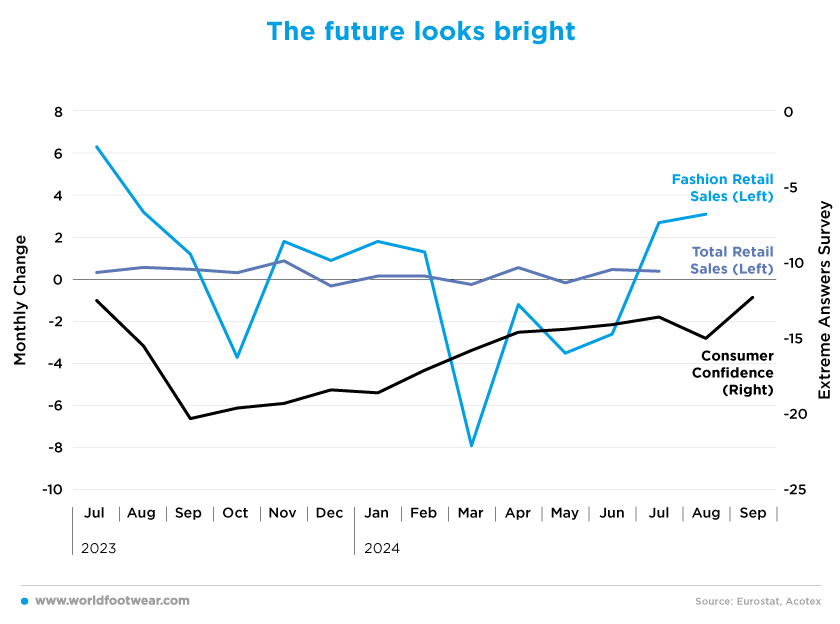Register to continue reading for free
Spain Retail: the future looks brighter for retail

Fashion sales finally picked up in July and August and are back in the green, after a worrying March. The truth is that the prospect of better economic growth and recent falls in inflation and unemployment have reassured Spanish consumers and given them a sense that the future may be brighter. All in all, this has led retailers to stock up in the hope that sales will continue to rise in the coming months. If these factors remain in place, the footwear sector is likely to end the year on a positive note
Back in the green
After four consecutive months of decline which affected all sectors of the fashion industry, fashion retail sales finally picked up in July and August. According to the barometer of the Association of the Textile, Accessories and Leather Trade (Acotex), sales of fashion products rose by 2.7% in July and again by 3.1% in August, making for a good start to the third quarter of the year.So far, the cumulative figure for the year is still negative (-0.8%), but it seems to finally be rising again. However, since September 2023, it’s also clear that there is a negative correlation between online sales and fashion retail, as fashion items are among the most bought online – for example, according to a recent study by Statista, footwear is the seventh most purchased item on Facebook and Instagram by national internet users.
The textile trade association described July’s rise as “below expectations”. “Good sales were expected because there was a lot of stock in stores at very attractive prices since products were not sold in season, but not everything that was expected was sold”, explained Acotex. On the other hand, the association attributes the increase in sales in August to the good performance of tourism in this summer campaign.
Therefore, looking ahead to the last four months of the year, Acotex is optimistic and hopes to “continue this upward trend in sales and end the year on a positive note” (revistadelcalzado.com).
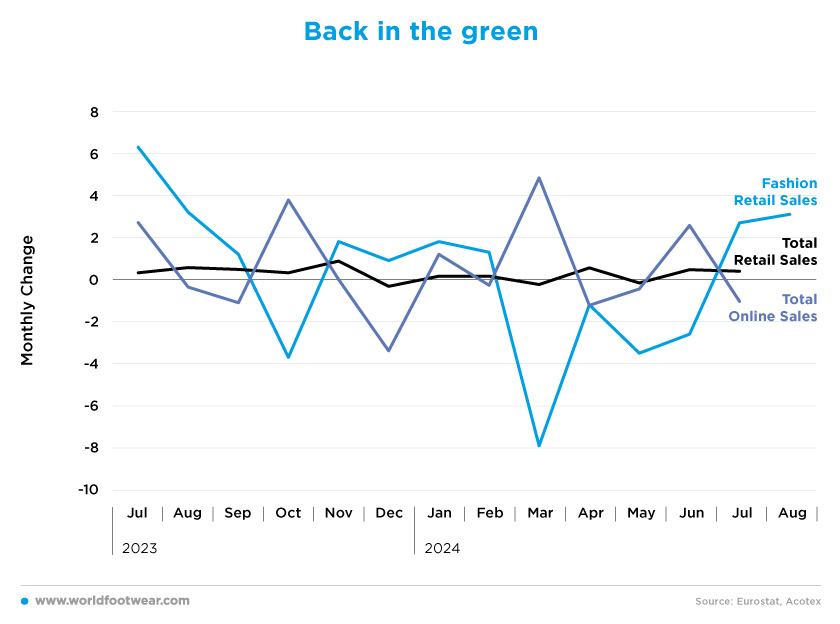
Building Trust
Over the past five months, footwear prices in Spain have stabilised, after the strong inflationary pressures of the previous year. In August, the inflation rate for footwear sold in Spain was 1.2%, a figure that has been constant since April.Looking at the National Statistics Institute’s data in more detail, women’s footwear was the most inflationary, rising by 0.4% last month, and men’s footwear followed with an increase of 0.2%. Meanwhile, prices for infant and children’s footwear fell into negative territory, decreasing by 0.2% (revistadelcalzado.com).
If we add clothing to the equation, the inflation rate rises to 2.5% in July and 1.8% in August. This tells us that among fashion items, footwear prices have been the most stable over the last year. As for the whole Spanish economy, the general consumer price index rose by 2.4%, with falls in electricity and food prices contributing to the inflation slowdown.
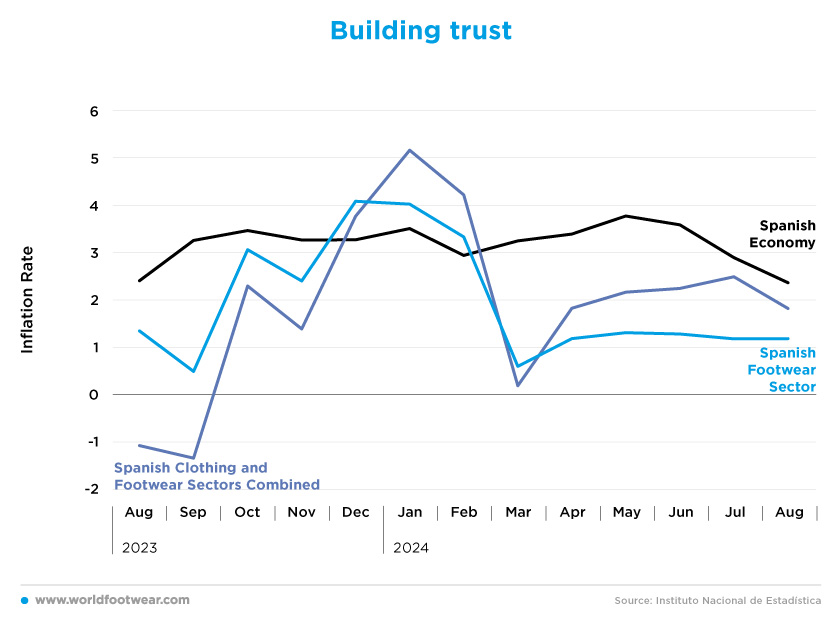
Eventually, they will meet
Although small, retail confidence has been positive and stable over the past twelve months. Yet this has not been the case for consumers.However, the trend in consumer confidence shows a steady upward movement that will hopefully match that of retailers. Consumer confidence in Spain is still at a low level (-10), but it is still better than most European countries.
In June, the Bank of Spain said that an expected boom in Spain’s tourism industry would buoy the country’s overall economic growth rate to a solid 2.3% in 2024, as more foreign tourists visit more areas of the country and spend more. According to Reuters, the country’s growth will outperform other major economies in the European Union and is well above the average 0.9% forecast for the eurozone in 2024.
Overall, the prospect of better economic growth and the recent falls in inflation and unemployment have reassured Spanish consumers and given them a sense that the future may be brighter.
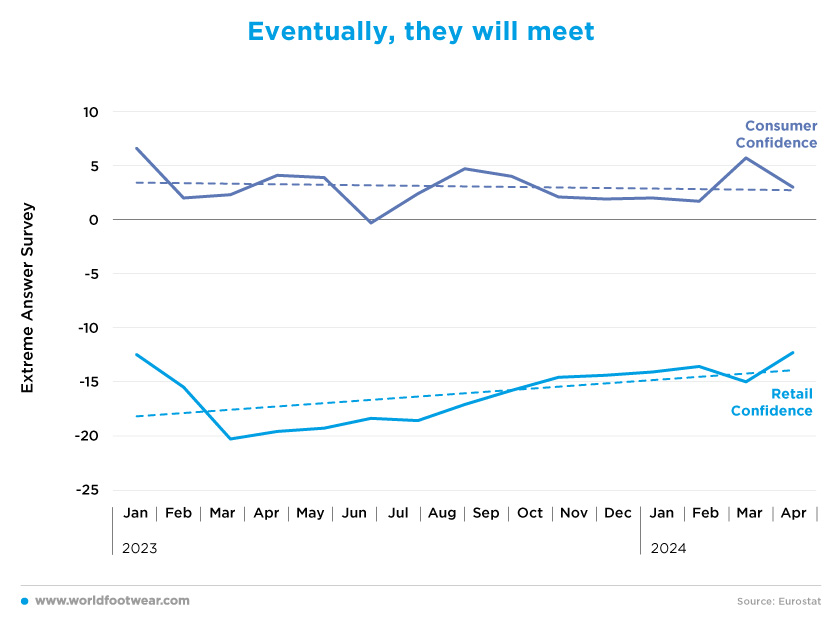
The big rebound
With fashion retail sales showing positive growth in recent months, Spanish retailers have placed their bets and restocked their stores. According to Eurostat data, the value of Spanish footwear imports rose by 44.1% in July compared to the previous month, something that hadn’t happened in more than two years. In total, they reached 449.3 million euros in July, breaking the 400 million barrier of the previous three months.
This value can be translated into 32.2 million pairs of shoes entering the country in August alone, with an average price of 13.97 euros, an increase of 0.57 cents per pair when compared to the average price per pair bought abroad in the first five months of 2024, which was 13.4 euros. The main suppliers in order of volume in July were China (52.77%), Vietnam (10.84%), Germany (6.29%), Belgium (5.81%) and France (5.05%).
Compared with the figures of 2023, from January to June, footwear imports increased by 3.8%.
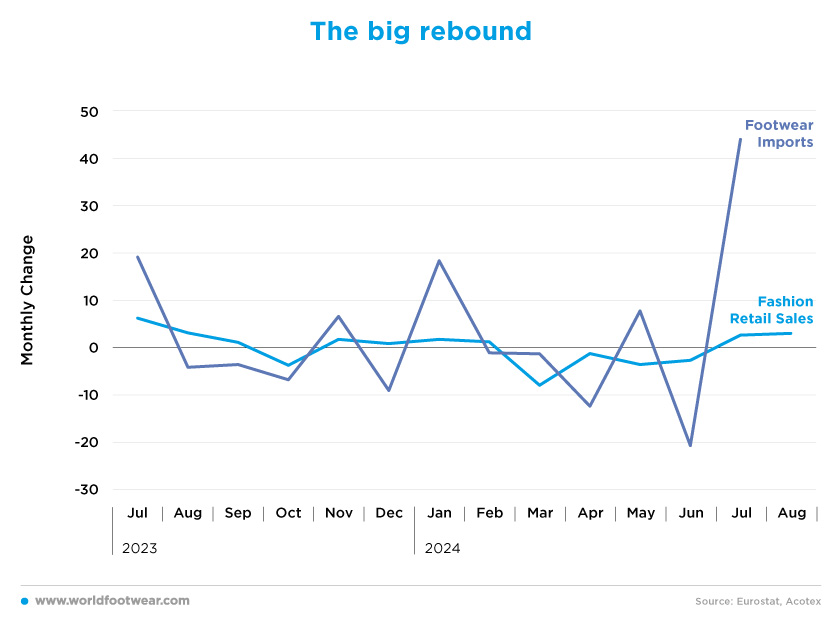
The future looks bright
With consumer confidence on an upward trend, a higher economic growth projection for 2024, two consecutive months of increases in fashion retail sales and a boom in imports, the future for Spanish retailers seems as bright as the North Star on a cloudless night.The footwear and leather industry created 8,800 jobs in the last quarter. With this significant increase in the number of active workers in the sector, all the jobs lost in the last year and a half have been recovered. Thus, according to the latest data from the National Statistics Institute (INE) on the Labour Force Survey (EPA), 55,200 workers were active in the footwear and leather industry at the end of June 2024 (revistadelcalzado.com).
Data from the National Statistics Institute showed that the Spanish economy grew at a faster-than-expected annual rate of 2.8% in the past quarter, suggesting, as previously mentioned, that it is likely to outperform other major eurozone economies this year. Better economic growth together with the stabilisation of inflation will lead to higher wages and more purchasing power for consumers. This may encourage consumers to go out, feeling comfortable enough to spend their now not-so-tight budget on fashion items.
All in all, retailers are now stocking up after a bright summer, in the hope that sales will continue to rise in the coming autumn months.
